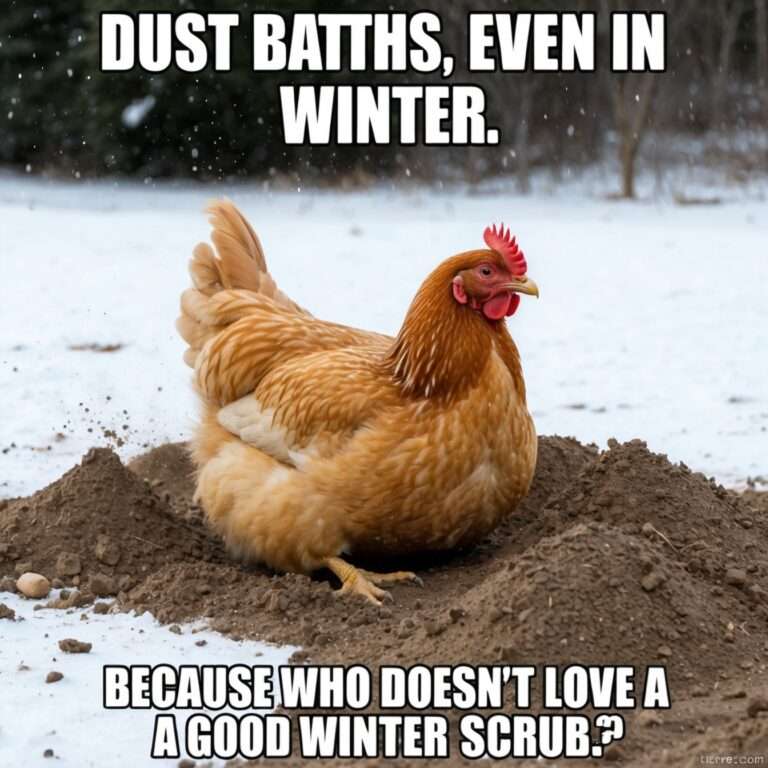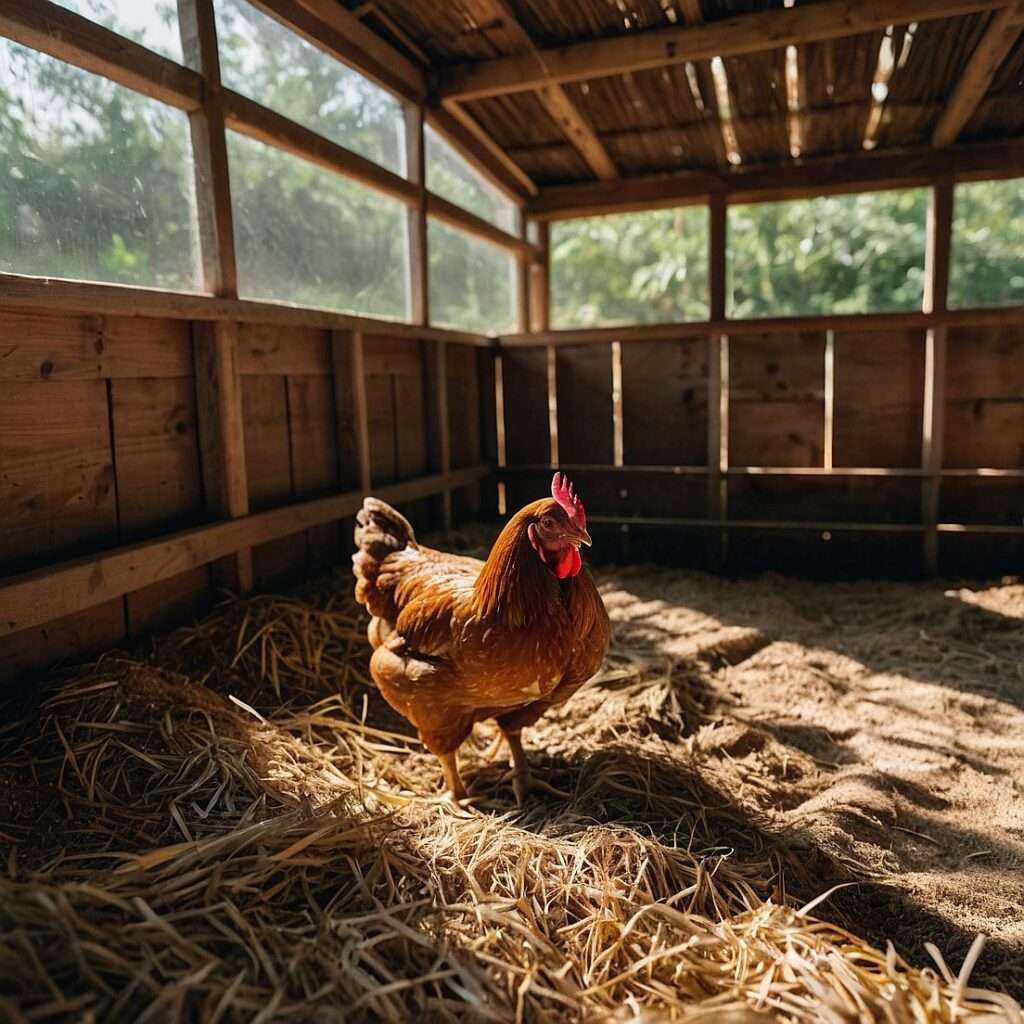
A mix of sand and straw in a chicken coop offers the benefits of both materials, including absorbency, comfort, and odor control
Choosing the right bedding for your chicken coop is one of the most important decisions you’ll make as a chicken keeper. Not only does bedding help absorb moisture and control odors, but it also impacts your flock’s comfort and overall health. Whether you’re aiming for a cost-effective, eco-friendly, or highly absorbent option, the perfect bedding material is crucial to creating a healthy, clean environment for your chickens. In this guide, we’ll break down the most popular bedding types, outlining their benefits, potential drawbacks, and which might work best for your coop.
1. Hemp Bedding: Best Chicken Coop Bedding
Description:
Hemp bedding is made from the inner core of the hemp plant, offering superior absorbency and an eco-friendly alternative to traditional bedding materials. While it’s gaining popularity, it may not be as widely available in all areas.
| Pros | Cons |
|---|---|
| Highly absorbent, reducing moisture and odors. | More expensive than many other bedding types. |
| Low dust content, improving respiratory health for chickens. | Limited availability in some local stores. |
| Long-lasting, requiring less frequent replacement. | May need to be ordered online or sourced from specialty retailers. |

2. Wood Shavings: Best Chicken Coop Bedding
Description:
Wood shavings, typically made from pine or aspen, are a popular choice due to their absorbent nature and the comfort they provide for chickens. They are widely available and fairly affordable.
| Pros | Cons |
|---|---|
| Great at absorbing moisture, keeping the coop dry. | Can create dust that may irritate the chickens’ respiratory systems. |
| Natural oils help control odors. | More expensive than some other bedding options. |
| Comfortable for chickens to scratch and nest in. | Requires regular replacement to maintain cleanliness. |
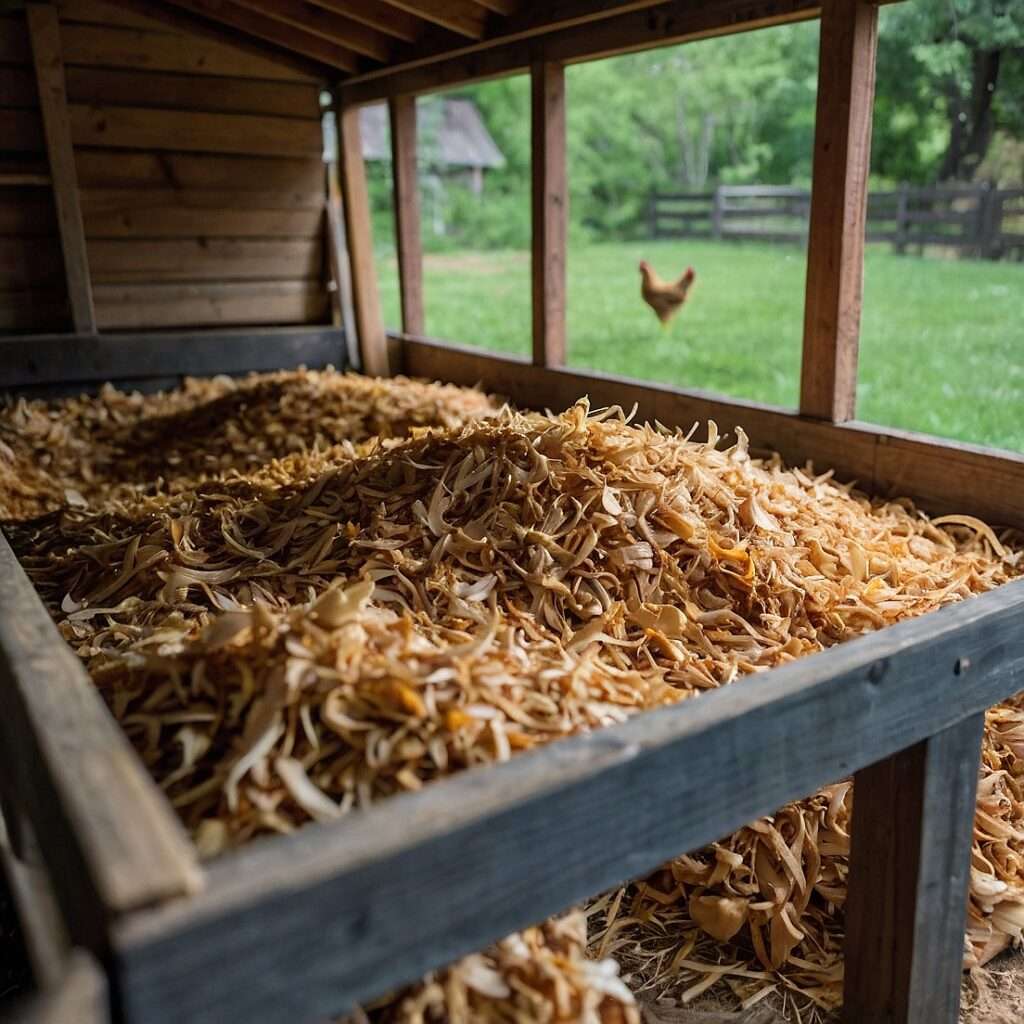
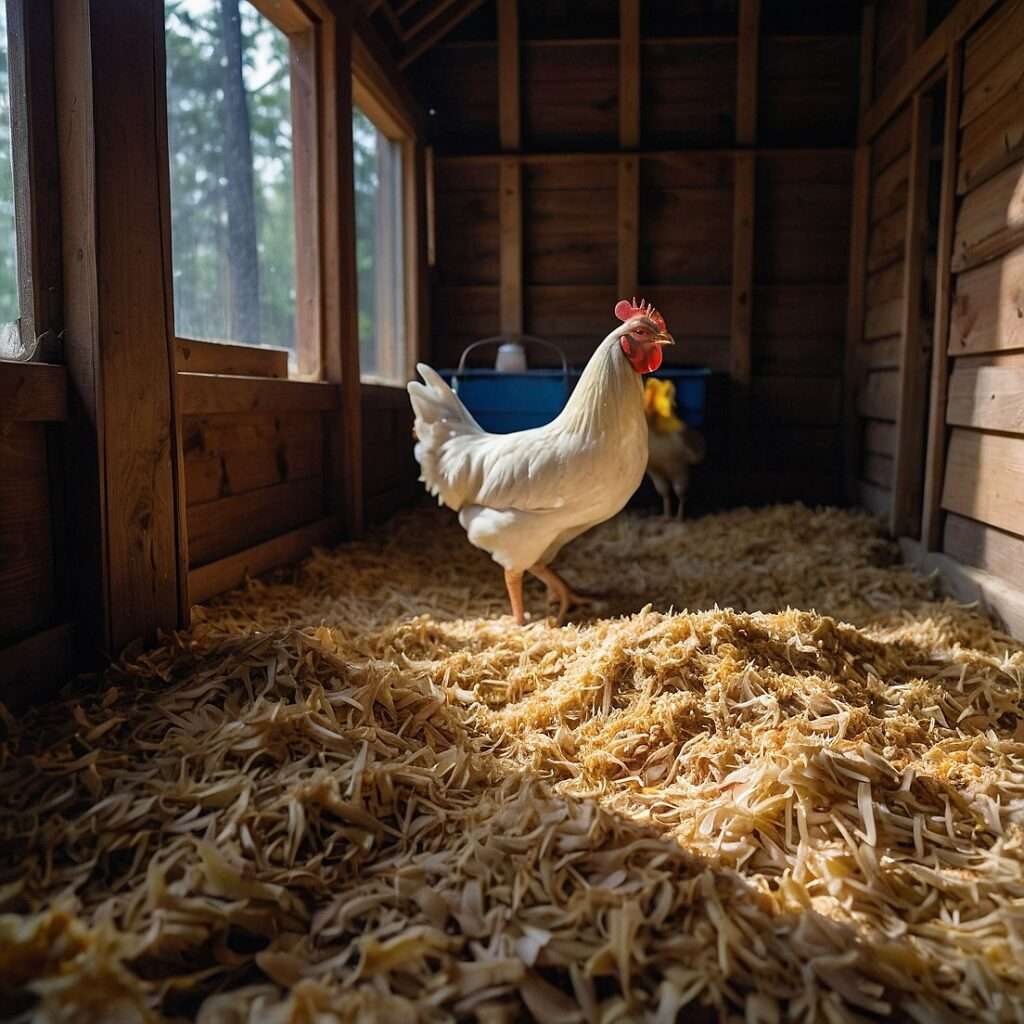
3. Sand: Best Chicken Coop Bedding
Description:
While not as traditional as other options, sand is gaining popularity for its excellent drainage and low maintenance. However, it may not be ideal for colder climates due to its lack of insulation.
| Pros | Cons |
|---|---|
| Excellent drainage that helps prevent moisture buildup. | Can be uncomfortable for chickens during cold weather. |
| Low maintenance—lasts for months with minimal upkeep. | Heavy and difficult to move or replace. |
| Helps control odors by preventing moisture. | May require additional bedding material to keep the coop comfortable. |


4. Pine Needles
Description:
Pine needles, also known as pine straw, are often a free resource for those with access to pine trees. They have natural odor control properties but are not as absorbent as other bedding types.
| Pros | Cons |
|---|---|
| Low-cost or free if you have pine trees nearby. | Less absorbent compared to other bedding options. |
| Natural odor control, thanks to the pleasant scent of pine. | Prickly texture that may not be as comfortable for chickens. |
| Compostable and great for garden use. | Needs frequent changes to maintain cleanliness. |
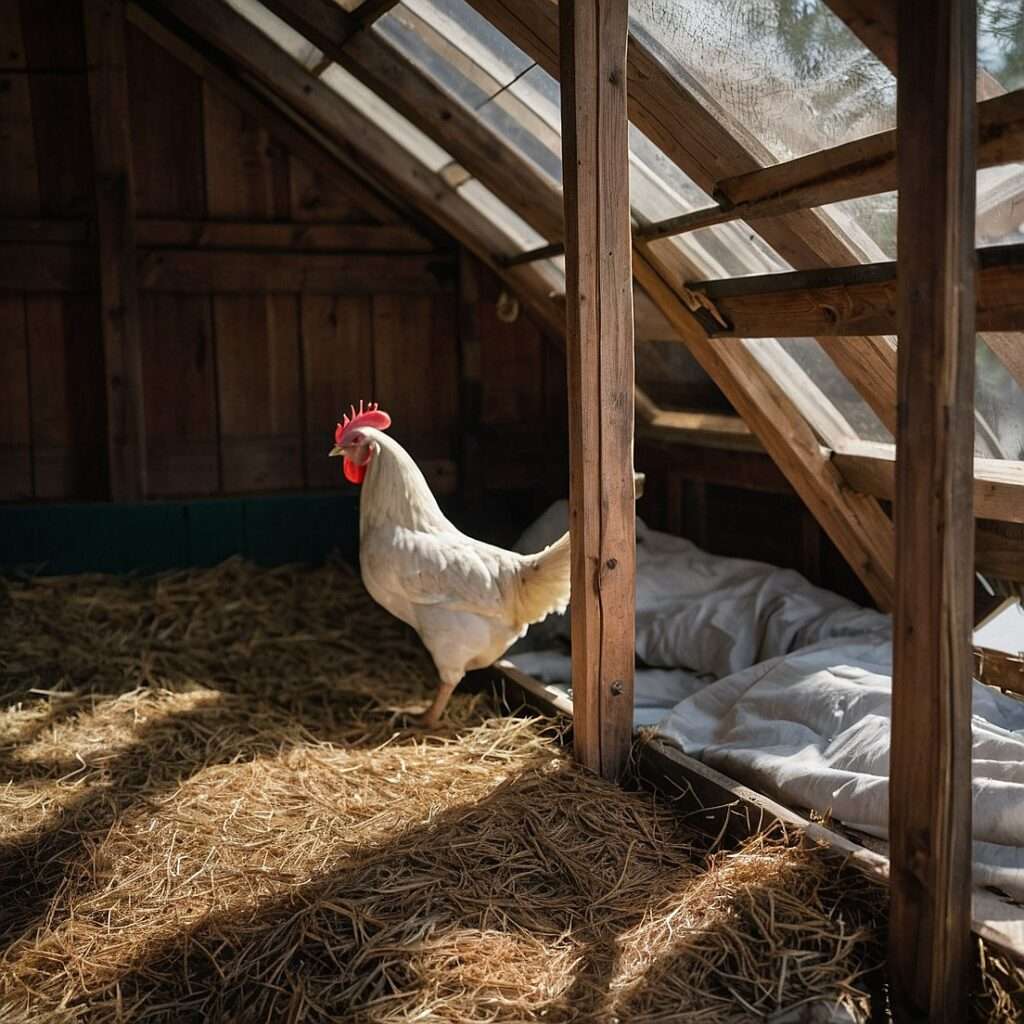
5. Straw
Description:
Straw is an affordable, widely available bedding material that works well for colder climates due to its insulating properties. However, it can be difficult to manage in warmer climates or if not replaced frequently.
| Pros | Cons |
|---|---|
| Cost-effective and easy to find. | Can become damp quickly if not changed regularly. |
| Good insulation properties, ideal for winter. | Can attract pests if not replaced frequently. |
| Compostable and can be used in gardens. | Less absorbent than alternatives like hemp or wood shavings. |
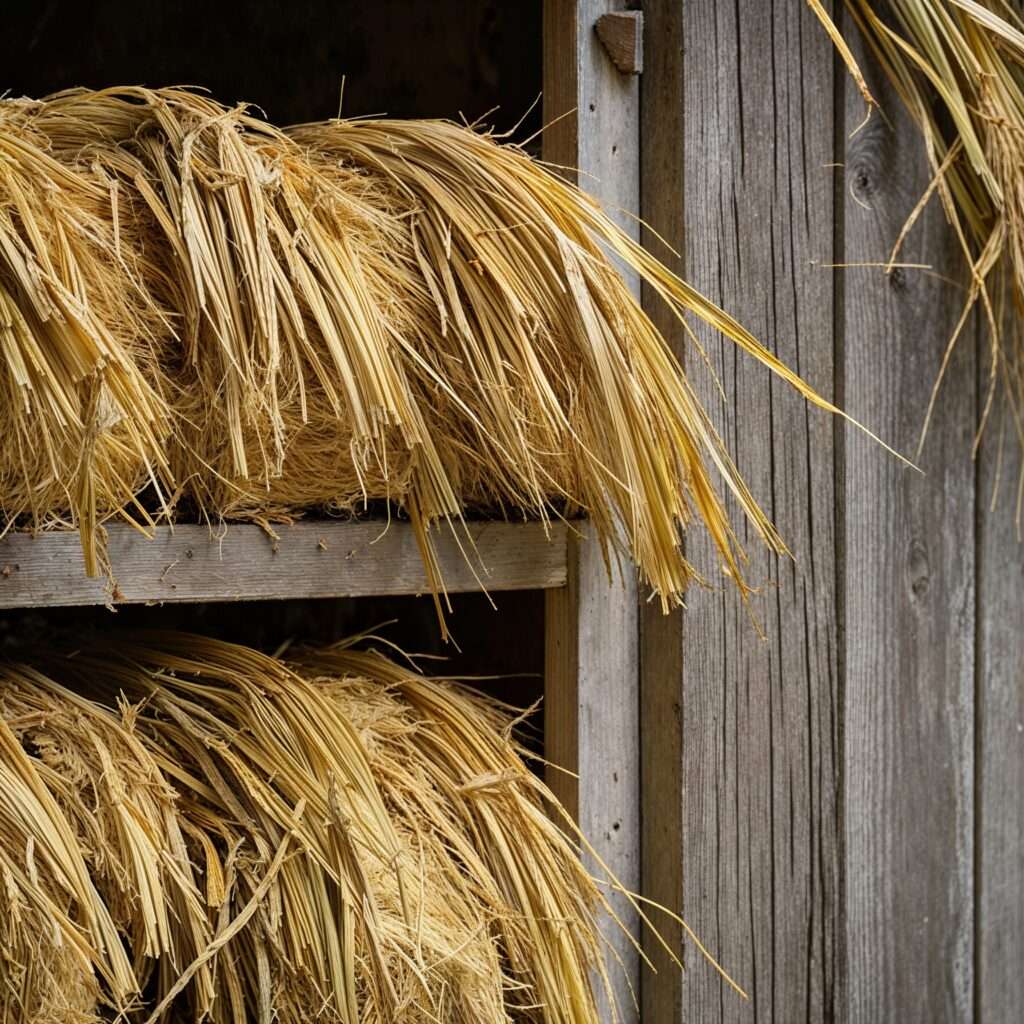
6. Coco Coir
Description:
Coco coir, made from the husk of coconuts, is an excellent option for absorbency and moisture control. It’s a bit more expensive than traditional bedding but offers great environmental benefits.
| Pros | Cons |
|---|---|
| Highly absorbent, wicking moisture away quickly. | More expensive than traditional options. |
| Low dust content, good for respiratory health. | May be harder to find locally. |
| Compostable and can be used to enrich soil. | Limited availability in some regions. |
7. Mulch (Wood Chips)
Description:
Wood chips or mulch can serve as bedding, especially in outdoor runs, where it can help keep the area dry and reduce mud. It’s durable but not as absorbent as other materials.
| Pros | Cons |
|---|---|
| Durable, lasting longer than other bedding materials. | Low absorbency, requiring more frequent cleaning. |
| Helps with odor control and keeps the coop smelling fresh. | May be too rough or uncomfortable for chickens. |
| Works well in outdoor runs, reducing mud. | Requires frequent maintenance to keep clean. |
8. Peat Moss
Description:
Peat moss is a highly absorbent bedding material that is excellent for moisture control. However, it has environmental concerns due to its harvesting methods and may be expensive.
| Pros | Cons |
|---|---|
| Highly absorbent and effective in moisture control. | Expensive, especially for large coops. |
| Comfortable for chickens to scratch and dust bathe in. | Harvesting peat moss can harm ecosystems. |
| Breaks down well and can be composted. | Not as widely available in some areas. |
9. Recycled Cardboard Bedding
Description:
Shredded cardboard is a cost-effective, eco-friendly option that is easy to acquire. However, it may require more frequent cleaning due to its lower absorbency.
| Pros | Cons |
|---|---|
| Eco-friendly, reducing waste. | Generates dust, which can be a respiratory concern. |
| Moderate absorbency, helping to control moisture. | Requires more frequent cleaning than other materials. |
| Soft texture that chickens enjoy. | Can become soggy and less effective if not replaced often. |
10. Leaves
Description:
Dried leaves can be an excellent, free resource for chicken bedding, especially in autumn. They are comfortable and compostable, though they have some limitations.
| Pros | Cons |
|---|---|
| Free and easy to gather during the fall. | Low absorbency, requiring frequent changes. |
| Soft, natural bedding chickens enjoy. | Breaks down quickly, needing regular replacement. |
| Compostable, great for gardens. | Can become too damp if not managed properly. |
11. Grass Clippings
Description:
Fresh grass clippings can be used as bedding, particularly in spring and summer. They’re free and easy to gather but require care due to moisture retention.
| Pros | Cons |
|---|---|
| Free and easy to gather. | Can hold moisture, leading to dampness. |
| Compostable, breaking down in gardens. | May mold if not fully dried before use. |
| Provides a soft bedding option. | Needs to be replaced frequently to avoid moisture buildup. |
12. Shredded Paper
Description:
Shredded paper, often recycled from old newspapers, is a budget-friendly bedding option. It’s soft but requires frequent changes due to low absorbency.
| Pros | Cons |
|---|---|
| Free if you have old newspapers. | Becomes soggy quickly and can smell bad. |
| Eco-friendly and helps recycle paper. | Needs regular replacement due to poor absorbency. |
| Soft texture for chickens. | Can create dust that may irritate chickens’ respiratory systems. |
13. Hay
Description:
Hay, commonly used as feed, can also serve as bedding. It’s soft and comfortable but requires regular upkeep to avoid mold growth.
| Pros | Cons |
|---|---|
| Soft, comfortable bedding for chickens. | Can easily become moldy if it gets wet. |
| Good insulation for colder climates. | More expensive than straw. |
| Provides chickens with something to scratch and peck. | Needs frequent replacement to avoid mold. |
Combining Bedding Types for Optimal Results
Sometimes, using a combination of bedding materials can provide the best of both worlds. Here are a few popular blends:
- Sand as a Base Layer with Straw or Hay on Top
- Pros: Provides excellent moisture control and comfort.
- Cons: Requires a bit of maintenance.
- Wood Shavings with Hemp Bedding
- Pros: Enhanced absorbency and long-lasting.
- Cons: Higher cost compared to using only wood shavings.
- Pine Needles and Shredded Paper
- Pros: Cost-effective, with good odor control.
- Cons: Requires regular cleaning to maintain effectiveness.
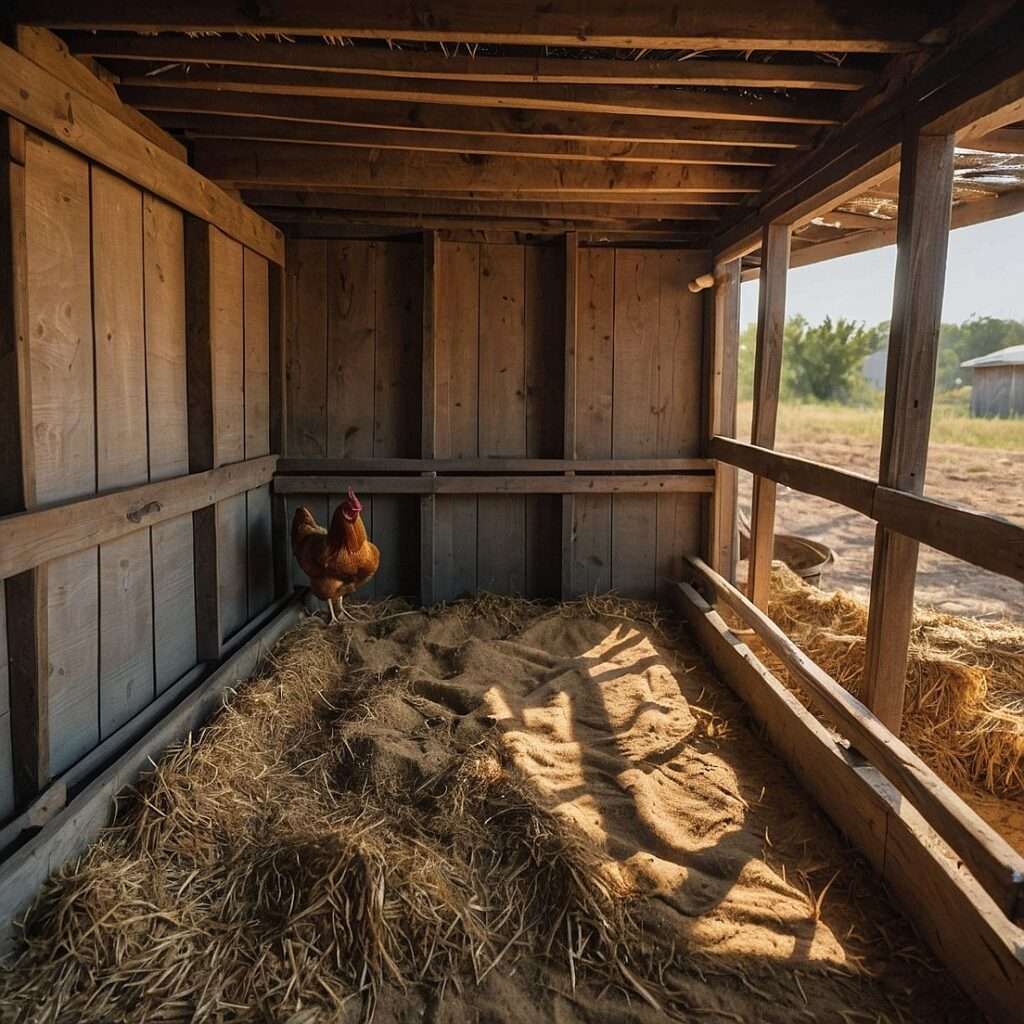
Conclusion
Selecting the right bedding for your chicken coop will depend on factors like climate, budget, and maintenance preferences. Hemp Bedding and Wood Shavings are excellent for moisture control and comfort, while Sand is low-maintenance but may not be ideal in colder climates. Combining different types, such as Straw with Sand or Hemp with Wood Shavings, can maximize benefits like absorbency and odor control. Experiment to find the best mix for your flock, ensuring their comfort and well-being while maintaining a clean, healthy environment.
Darwin’s Take: The Bedding that Binds Us
On the surface, the question of which bedding best suits your chickens might seem trivial—an issue relegated to the mundane chores of animal husbandry. But to truly understand what we’re choosing when we select our bedding, we must look deeper. What is bedding if not the metaphor for the fragile ecosystems we construct to sustain life? Beneath the straw, beneath the hemp, beneath the sand and the cedar shavings, lies a reflection of how we treat the delicate balance of life—and death—around us.
More Reading on Paranoid Prophet
Wheatgrass Hay & Winter Chickens: Learn about the benefits of wheatgrass hay for your chickens during the winter months. This article explores how adding wheatgrass to their diet can enhance your flock’s nutrition and overall health, helping them thrive through colder seasons.
Winter Chicken Memes and Facts: Dive deeper into the lighter side of chicken care with a collection of winter-themed chicken memes and fun facts about how chickens handle the cold. You’ll discover amusing insights and practical tips for your feathered friends in winter.
Poultry Care & Backyard Flocks: Explore the full range of poultry care content, where you’ll find articles on optimizing your backyard flock’s health, well-being, and happiness. Whether you’re new to raising chickens or a seasoned keeper, this section provides valuable advice for every aspect of chicken ownership.
Sources
Selecting the appropriate bedding for your chicken coop is crucial for maintaining a healthy and comfortable environment for your flock. The following sources provide comprehensive insights into various bedding options, their benefits, and considerations:
- “The Best (& Worst) Chicken Coop Bedding: Your Options” – Backyard Chicken Project
This article evaluates different bedding materials, highlighting the advantages of pine shavings and the potential respiratory risks associated with cedar shavings. Backyard Chicken Project - “Best Chicken Coop Bedding – A Must-Read Guide” – BackyardPets
This guide discusses various bedding materials, including straw, wood shavings, and hemp, offering insights into their suitability for different climates and coop setups. Backyard Pets - “8 Best Bedding Options for Your Chicken Coop” – Daily Chickens
This resource provides a detailed analysis of bedding options such as straw, pine shavings, and sand, considering factors like absorbency, odor control, and ease of maintenance. Daily Chickens - “The 10 Best Chicken Coop Bedding Options – Reviewed” – Zacs Garden
This review offers a comprehensive comparison of bedding materials, focusing on aspects like cost-effectiveness, odor control, and impact on chicken health. Zac’s Garden - “Best Chicken Coop Bedding: A Guide to Choosing the Right Type for Your Flock” – ABigFarm
This guide explores various bedding types, emphasizing the importance of selecting materials that promote hygiene and comfort within the coop. A Big Farm
These sources collectively provide valuable information to help you make informed decisions about the best bedding options for your chicken coop, ensuring the well-being of your flock.
FAQ: Best Chicken Coop Bedding Guide
General Questions
1. Why is choosing the right bedding important for a chicken coop?
Proper bedding helps maintain a clean, odor-free environment, reduces the risk of diseases, and provides comfort for your chickens.
2. What are the most common types of chicken coop bedding?
The most popular types include straw, wood shavings, sand, shredded paper, and hemp. Each has its pros and cons depending on your climate and flock needs.
3. How often should I change the bedding in a chicken coop?
For most bedding types, it’s recommended to change it every 1-2 weeks, or sooner if it becomes damp or soiled. Deep litter methods may require less frequent changes.
Specific Bedding Types
4. Is straw good bedding for chickens?
Straw is affordable and insulating, making it great for colder climates. However, it can become moldy if wet and isn’t as absorbent as other materials.
5. Are wood shavings safe for chickens?
Yes, pine shavings are safe and highly absorbent. However, avoid cedar shavings, as their strong scent can irritate chickens’ respiratory systems.
6. Can I use sand in my chicken coop?
Yes, sand is an excellent option for hot climates as it stays cool and drains moisture well. However, it requires regular raking to remove droppings.
7. Is hemp bedding worth the cost?
Hemp bedding is highly absorbent, dust-free, and lasts longer than most other options. While it’s more expensive upfront, it may save money over time due to its durability.
8. Can shredded paper be used as bedding?
Shredded paper is an affordable and eco-friendly option, but it isn’t very absorbent and can become damp quickly, requiring frequent changes.
Deep Litter Method
9. What is the deep litter method?
The deep litter method involves layering bedding material and allowing it to compost over time. It reduces waste, generates heat, and requires less frequent cleaning.
10. What bedding works best for the deep litter method?
Wood shavings or straw are ideal for this method because they compost well and provide insulation.
11. How often should I turn the bedding in the deep litter method?
You should turn the bedding weekly to aerate it and speed up composting. Add fresh bedding as needed to cover droppings.
Maintenance and Cleaning
12. How do I keep coop bedding dry?
Ensure proper ventilation, repair any leaks, and use absorbent bedding like wood shavings or sand to keep moisture levels low.
13. Can I compost used chicken bedding?
Yes, chicken bedding mixed with droppings makes an excellent addition to a compost pile. Allow it to compost fully before using it in gardens to prevent burning plants.
14. What are the signs of poor bedding choice?
If your coop has strong odors, excessive dust, dampness, or chickens appear uncomfortable, it may indicate the need to change bedding types.
Seasonal Considerations
15. What’s the best bedding for winter?
Straw and wood shavings provide good insulation during colder months. The deep litter method can also help generate warmth.
16. What’s the best bedding for summer?
Sand works well in summer as it stays cool and allows for quick drainage, keeping the coop dry and comfortable.
